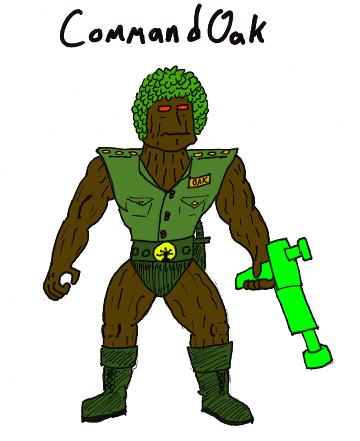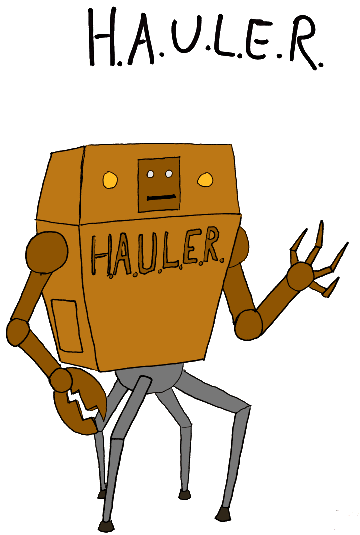This week I have a superhero inspired by the heroes of cartoon I grew up with, and also some robot. bookofpdr.com/2013/04/21/sup…
Super Sunday: CommandOak and HAULER

CommandOak
There is a secret magical forest called Arborika, and an evil pollution-loving corporation want to get in there and steal all the magic wood. But luckily for Arborika, there are CommandOak and the Forest Force, magic tree-people who fight the evil corporation’s weekly schemes.
Other members of the Forest Force would include the Maple Leaftenant, Na-Palm, Brigadier Birch, and so on.
Here, I wanted to tap into 80s toy-style heroes so I combined the aesthetics (and terrible name schemes) of He-Man with the military trapping of G.I. Joe and then threw trees into the mix. In case it isn’t obvious, he’s got bark for skin, leaves for hair, and those are supposed to be acorn buttons on his shirt. Also, I picture that gun being bright orange.
(The Captain Planet-style villains are, I admit, more a 90s thing than an 80s one, but whatever, shut up.)

HAULER
The Hundred-Armed Urban Law-Enforcing Robot was designed to meet the needs of a world where superhuman criminals are unfortunately common. While strong and durable, the real feature of HAULER are the side panels that lead to micro-storage units containing a plethora of different arm attachments for a myriad of different uses. Claws, grappling hooks, flame throwers, various restraints, and a multitude of weapons. This is one robot who always has something… up its sleeve. (No apologies)
“Hey PDR,” said nobody ever, “you need to design another robot!” HAULER would be a non-sentient robot, though. Most of the time in comics, it’s taken for granted that the robots can think and feel and laugh and love. This is an exception because there should be exceptions. A story about HAULER would be about have to be about the people who control him, probably from some remote back at police headquarters, rather than about the robot himself. Some sort of procedural soap opera deal, I guess.
Canadian Baseball Teams Can Be Less Racist
There’s this thing called baseball, for some reason. Anyway, for a long time we didn’t let black people play it with white people, until that changed. Some of that happened in Canada, so you better believe we have a Heritage Moment about Jackie Robinson. The Moment opens in a locker room of the Montreal Royals (but we don’t get to see any dongs) as team owner or manager or whatever he was, Mr. Rickey, introduces the team to Jackie, the first black man to play in whatever league of their little game they are in. Later (his first game, I guess?) Jackie is at bat, but the opposing pitcher hits him with the ball. Jackie’s teammates are upset by this, naturally, but so is the Canadian crowd (we sadly don’t get to see if the pitcher looks sheepishly at his feet while mumbling that he’s sorry). Before long (four innings, according to my research, is less than a week), the crowd is chanting Jackie’s name and Racism has to crawl back into its cave to strike another day.
First of all, I doubt that Jackie’s teammates first learned about Jackie one day when Mr. Rickey came along and said, “Hey, check out this new guy!” Probably it came up in conversation before that? I don’t know for sure, but it seems likely to me. Also, we all know that in the real world Mr. Rickey was played by Harrison Ford. The real problem highlighted in this piece though, see that sign behind Jackie saying “No Women or Children Allowed.” When are we going to let women and children into our sports team locker rooms? When will the we finally be together? Also, “No spitting”? Whatever, man.
Okay, anyway, it may have come across that I think baseball is ridiculous and pointless. That is correct. But Jackie Robinson’s story isn’t one about winning a baseball game, it’s about breaking down the arbitrary barriers that racism built up in society. If those barriers exist in some silly game, it is as important to break them there as anywhere. For that reason, I can actually care about Jackie Robinson’s story. How does the Moment do? Well, it’s a bit cheesy (Montreal Royal with Cheese?), but it tells the story clearly in the time allowed, and makes Canadians feel good about themselves by having the crowd support him. That’s what these are supposed to be for. Sadly, there’s no lines that are burned into my head (though I’d love to have Mr. Rickey’s introduction of Jackie down), and that is what PDR considers most important. Altogether, I suppose I’d have to give this Heritage Moment Four out of Six Pieces of PDR’s Reviewing System Cake.

